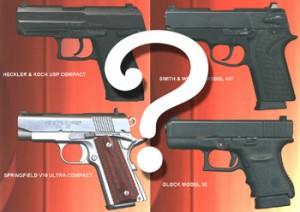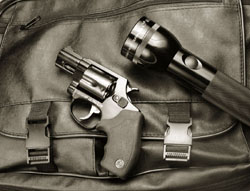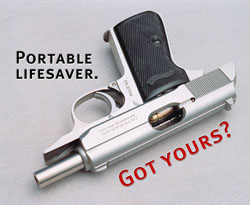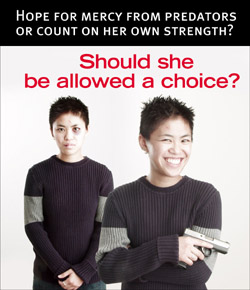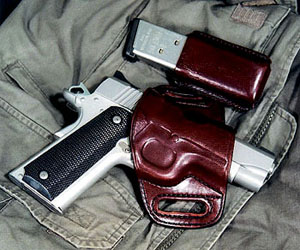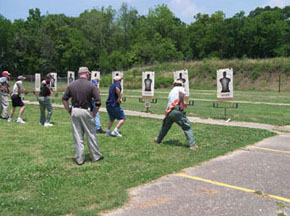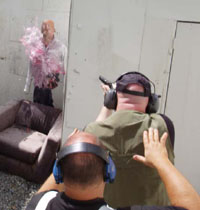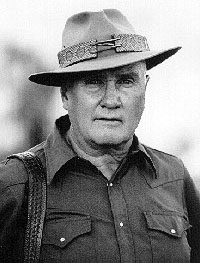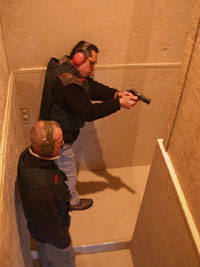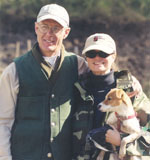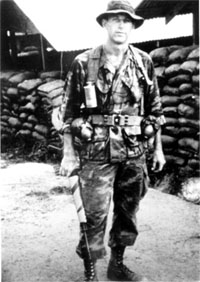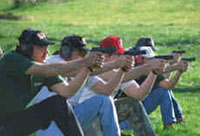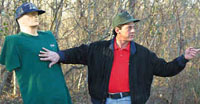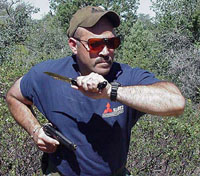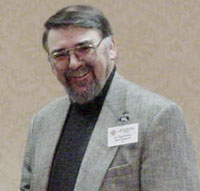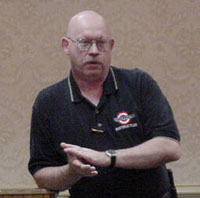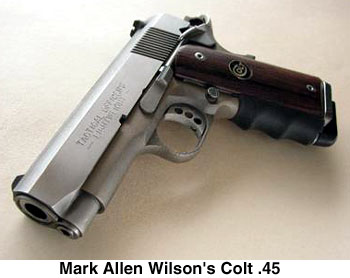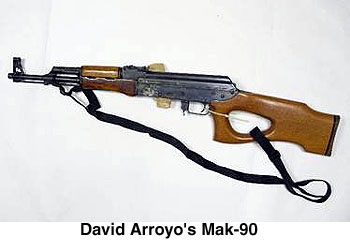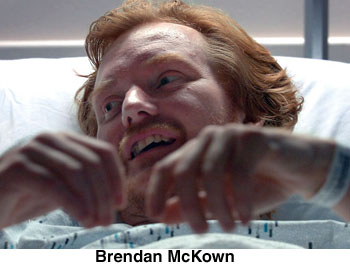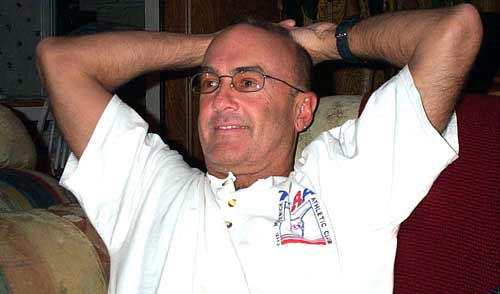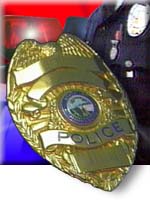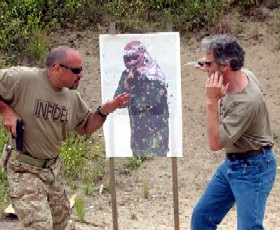By Mark H Parsons From “Guns & Survival” Magazine, 1991
The American Pistol Institute, near Paulden, Arizona, is probably the most famous small arms training facility in the world. Founded and directed by Jeff Cooper, it’s the philosophical seat for what has come to be called the Modern Technique of the pistol.
Although most of us under forty probably grew up taking these things for granted (the use of the two-handed Weaver stance, the rapid acquisition of the front sight prior to firing, the superiority of a major caliber handgun, etc.) such was not always the case. For the most part these things were either discovered, or observed, refined, and reported by Cooper, and it would be safe to say that without his teachings we would probably still be shooting one handed from a “combat crouch,” using point shooting as the aiming method.
This would be reason enough for me to want to take a trip to Gunsite Ranch (the home of API) but I also had a practical reason – I wanted a thorough grounding in the practical use of the 1911- type pistol.
Although I’ve been an advocate of Cooper and his teachings for years, I’ve tended more toward the use of revolvers than autos. While a bad experience in the late ’70s with a 1911 clone and similar troubles with a friend’s hacked-up Colt, I still knew that I could potentially achieve better results with an autopistol – I decided it was time to bite the bullet (as it were) and make an effort to master the gun; and what better place to start than at Gunsite?
With this goal in mind, my buddy John and I got our equipment together (see sidebar: Gear for Gunsite) and headed out to Arizona for a week of some of the most relevant firearms instruction one could hope to acquire. (Relevant to what? To the real world, of course…)
What follows is an account of our week at the American Pistol Institute.
DAY 1 – THE FRONT SIGHT
Our group of 19 sat in the classroom at 0800. We were introduced by operations manager Bill Jeans to the staff members who would assist with our training. Our rangemaster was Ed Stock, and our shooting coaches were Lloyd Pond, Mike Norris, and Nigel Milner.
Colonel Copper’s wife, Janelle, gave a very hospitable welcoming speech which made us feel at home, and Cooper gave an opening lecture on safety. His thought on this is that no mechanical device h as a will of its own, and guns don’t fire unless someone causes them to do so. In light of this, firearms safety boils down to four simple but absolute principles:
1. All guns are always loaded. No exceptions.
2. Never let the muzzle cover anything you are not willing to destroy. You can’t negate this rule by claiming the gun isn’t loaded… refer to Rule 1.
3. Keep your finger off the trigger until your sights are on the target. At Gunsite they call this the Golden Rule, because they’ve determined that the majority of negligent discharges could be prevented by strict adherence to this rule.
4. Be sure of your target. Identify your target, identify what’s between you and your target, and identify what’s behind your target.
Along with the safety lecture he also covered the Gunsite Code of Offenses, which includes such interesting infractions as (401) asking if “make ready” means “load,” (403) whimpering, and my favorite (601) conspicuous stupidity in a public place.
After this he explained the Combat Triad (Mindset, Gun handling, and Marksmanship) which comprises the fundamentals of practical shooting.
Today he focused on Marksmanship, which is divided into two sections. The principles of practical marksmanship, which are accuracy, power and speed (in Latin, Diligentia, Vis, and Celeritas, commonly abbreviated as DVC) and the five elements of the modern technique of the pistol: the Weaver stance, the flash sight-picture, the compressed surprise break, the presentation, and the heavy-duty pistol.
After lunch, we headed to the range, where Cooper and the coaches inspected our weapons and gear and made practical suggestions. (Example: A woman with extremely small hands was having problems reaching the trigger on her .45 due to an after market “long” trigger. They suggested she swap back to a short trigger, which she did at the on site gun smith, and her problem was solved.) They also observed our firing grip and stance and made suggestions.
On the first day all shooting was done starting from the “guard,” or Weaver ready position. The drill was simply to raise the pistol, get a quick sight picture, and press the trigger. We started with single shots from three meters, then back to seven, ten, and fifteen meters, taking only enough time to insure a center mass hit at that particular distance. Then we went to shooting doubles (controlled pairs-reacquiring the front sight for each shot) at the same distances.
We also practiced tactical reloading (inserting a full magazine into the weapon while retaining the partially empty one for possible future use) during these drills.
At Gunsite they place high value on dry practice, and every night after class we were told to work on certain things in our rooms. The homework for the first day was to start from the guard position and as quickly as possible lift the weapon, obtain a flash sight picture, and press the trigger, checking after each time to see if the sights were indeed lined up on the target when the hammer fell. Extreme emphasis was placed upon looking at the front sight, rather than the target, at the moment of firing.
Quote of the day: “You will make a god of your front sight, and worship it faithfully.” – Cooper
DAY 2-LIFE IS TOUGH
Cooper started the day with a lecture on the presentation of the pistol from a holster. He teaches this in five distinct steps, each step having a key memory word that reminds you of the correct action (ie. grip, clear, click, smack, look).
You learn it “by the numbers” to program the correct sequence into your mind, but once you’ve learned it, it becomes one motion. Cooper says that trying to make it fast will make it jerky, while trying for smoothness will give you true speed.
We went to the range and practiced our presentations (dry, at first) under the watchful eye of Ed Stock and the coaches. I have a slight tendency to hunch when I draw, which they quickly caught and corrected. This helped smooth things out for me a bit when we went on to the next drill, which was to draw and place a hit in the X-ring of an Option target in a couple of seconds.
We worked at this for quite a while. My partner, John, is left handed, and while the ambidextrous safety on his pistol had a rather large shelf on the left (unused) side, the lever on the right side was narrow, and the whole thing had plenty of sharp edges. They taught us to ride the thumb safety (it felt awkward to me at first, but now it’s second nature and by noon John’s left thumb was pretty cut up, so at lunch we wandered over to the gunsmith.
The ‘smithy at Gunsite is a full service shop: they can do everything from while-you-wait parts swapping to building a finished gun from a block of steel. John explained his problem to Sam Trevino, one of the smiths on duty at the time, and went to lunch. Within an hour his gun was ready.
Sam had understood the problem well. He installed an Ed Brown ambidextrous safety (with a wide ledge on the right side), but before he installed it he removed most of the left side lever and smoothed all the sharp edges off of both sides. John was a happy shooter once again. Appropriately enough, after lunch Cooper lectured on weapon modifications and one of the first things he mentioned was the need for a pistol to be dehorned. He covered everything from “necessary” mods (dehorning, high visibility sights, good trigger, solid bushing) through “useful,” “ok” and “questionable” (the last included ducktail grip safeties, recoil buffers, and ambi safeties for right handers) on through “objectionable” after market modifications (extended slide stops, squared trigger guards, compensators, recoil spring guide rods, etc.)
It’s important to realize that these aren’t merely opinions based on personal likes or dislikes, but conclusions resulting from the training of thousands of shooters, firing millions of rounds through almost every permutation of handgun available today. If there’s a way a gun can malfunction, it’s probably happened at Gunsite, one time or another. As an example of this, during the shoot-off a student had his pistol (a big-buck gun built by a big name smith) choke on a recently changed (under 500 rounds) recoil buffer that came unglued. It cost a good shooter crucial seconds in a match (which I expected him to win), and on the street it could cost him his life.
We went back to the range and worked on the Mozambique drill, or “failure to stop” drill, as it is sometimes called. Emphasis was placed on the fact that the head shot must be made with precision, and must not be missed.
Our dry fire homework was to practice our presentation and first shot such that we could draw and hit the X-ring of an Option target at seven meters within 1.5 seconds.
That night in the motel room practicing this, I realized that my draw had improved more in that one day than in years of doing it on my own. (For a good description of the pistol presentation as taught at Gunsite, get a copy of “To Ride, Shoot Straight, and Speak the Truth” and check out the chapter on “The Firing Stroke.”)
Quote of the Day: “Life is tough. It’s even tougher when you’re stupid.” -Ed Stock
DAY 3 – NO APPOINTMENT FOR EMERGENCY
This morning Cooper lectured on the use of the tactical load and the speed load, then we went, to the range to practice our speed loading.
Like most techniques they taught us, first we learned it by the numbers, in order to learn the correct sequence, then continuous but slow, to achieve smoothness and form, and then at full speed. They made a point of teaching us not to release the magazine in the gun until the spare is in the left hand. Failure to heed this can result in what Cooper calls “speed unloading.”
Once everyone was up to speed on this we ran 1+1 drills (shoot one round-reload-shoot one round) and then 2+2s. As you may have noticed, most of the drills run during this course consist of one or two shots. There aren’t any of those “twelve rounds in 24 seconds” stages, because that’s counter to what this class is all about: surviving a sudden, violent encounter.
After lunch we received copies of Cooper’s classic booklet “The Principles of Personal Defense” and Cooper talked about the combat mindset, sprinkling the lecture with relevant anecdotes to illustrate its different aspects. These aspects include the color code, which describes the various stages of alertness, (ie., white=unaware, yellow=unspecific alert, orange=specific alert, red=fight) and he explained at what stage one should be at any given point, and what actions should trigger an escalation of stages. Different incidents were given as examples.
The key lessons to be derived from all this are that one should be aware of his surroundings and any potential threats therein at all times, and that aggressors aren’t usually expecting violent resistance, so that one who retaliates quickly and with force stands a very good chance of winning. In other words… be alert and fight back! Learning firsthand from Cooper about the combat mindset was really the fundamental reason I came to Gunsite, and I wasn’t disappointed; it was worth the price of admission.
After this we went back to the range where we worked on the assumption of the kneeling position. One of the key points here was that not only should you be able to assume the kneeling position quickly, but you should be able to get up and out of it quickly. The goal was, at the whistle, drop into kneeling and place two shots into the X-Ring in 3.5 seconds.
We finished the day by working on pairs to the center of mass, and head shots. Our homework was to continue work on the presentation, from both standing and kneeling positions.
Quote of the day: “You cannot make an appointment for an emergency.” – Cooper.
DAY 4 – ISOSCELES PERVERSION
This was a busy day. Cooper’s opening lecture was on tactics. He covered movement around corners, the proper way to conduct a search, scanning hostile territory, and of course, watching your front sight. We’d get the opportunity to put these ideas into practice before the day was out.
We went to the range, and while the rest of the class worked on short range speed drills, squads of four or so would leave to run simulator drills. Two simulators were run on this day.
The first of these was the North Draw, an outdoor gully walk with hostile “pepper poppers” strategically placed in various locations such that if you don’t apply good tactics they’ll get you before you can get them.
Next we went to an indoor simulator called the Playhouse, which had several hallways, doors, and windows. You had to clear every corner using good tactics, and there were plenty of decision-making targets (hostiles, hostages, and bystanders) to keep things interesting.
This was an educational experience. In some of the “close and quick” simulations I tended to focus on the target and point- shoot, rather than acquire a flash sight picture prior to firing. I hit quickly, but upon examination of the targets afterward I realized that the hits weren’t always in the optimum place. I was warned that this could happen, and it did. Well, I was here to learn, and I’d get a chance to profit from my mistakes the next day.
After lunch we worked on the roll-over prone position, shooting from 25 meters. The goal was to drop into prone and place a pair of shots into the center of mass within seven seconds. This wasn’t a speed drill as much as a “form” drill, because once the process is learned correctly it’s possible to assume the position and get shots off in much less time. The key is to do it smoothly, keeping your eyes on the target while you’re getting into position. It may be somewhat quicker to look down as you hit the deck, but it’s tactically incorrect, for obvious reasons. Another example of the difference between the match mentality and the street mentality.
After this, Cooper discussed extremely close and fast shots. He had us start from three meters in the guard position facing 45 degrees to the right of the target, not looking at the target. At the whistle we had half a second to look at the target, line up in a quick Weaver, and fire. We did this three times, then repeated the drill starting 45 degrees to the left of the target. The purpose of this is to demonstrate that hits can be made rapidly, providing you use the correct technique. It worked as advertised, and most of us were pleasantly surprised to find six hits in the center of mass after the drill.
We proceeded to the “eyes-off” drill, which was also done at close range. The shooter looks at the target and commences his firing stroke, closing his eyes when his hand grips his weapon, he continues the “stroke” until the shot is fired. This is done three times. Examination of the target will indicate whether your complete presentation is in alignment. My hits were in a group to the right of center. Ed Stock said that the size of the group indicated that my firing stroke was correct but the placement meant that my stance was slanted too far to the right. I ran the drill again using his suggested foot placement and all my hits were in the center. Another minor revelation…
After a break for dinner our group met in the classroom and the coaches lectured on the various mistakes made during the day’s simulator runs (and yes, ignoring the front sight was a prominent no-no.) After each coach’s report, Cooper would lecture about the appropriate tactic.
After a brief discussion of night shooting we went back to the range to get some practical experience in this matter. At first, before it was completely blacked out, they had us shoot without flashlights to show that you can make close range hits without them as long as there’s enough light to identify your target. After this we shot in pitch black with flashlights, using the Harries technique. This involves holding the light in Your support hand under your shooting arm, with arms crossed at the back of the wrist. More important than how you hold the light is how you utilize it – bad use is worse than no light at all. Taking care not to illuminate yourself, the light should be used for a very short period of time, then switched off, at which time you should move to a new location.
Quote of the Day (possibly inspired by one of the coaches commenting on John’s tendency to revert to isosceles under stress during the simulators): “The isosceles stance is not an acceptable alternative, but a perversion.” -Cooper
DAY 5 – CLEAN YOUR GUNS
The first thing we did was go to the range and shoot the “basic drill” for Cooper. This is a 10 round drill which includes a little bit of everything we’d learned, from pairs in a second and a half at seven meters to shots from kneeling and prone at longer distances.
After this we went to run more simulators. The outdoor one, the Donga, was a gully walk similar to the North Draw, only the hostiles were “sneakier.” (l don’t know what Donga means, but it probably translates as “valley of death for unaware students.”) The only instructions I received prior to running this drill were “Two hits per gook” and a big grin from Lloyd, the coach.
The indoor simulator, the Funhouse, was like yesterday’s Playhouse, except, again, perhaps a bit more difficult. This time I made sure I was fixed on my front sight as I let fly and I made better hits than yesterday, and just as quickly, too. (Live and learn, right?)
Following the lunch break Cooper gave his lecture on power. This is a chalk-talk on the subject of which calibers are more effective than others, and why. He presents the information in a scientific, objective manner, covering both the kinetic energy and momentum schools of thought, along with lots of empirical data. Cooper speaks on handgun cartridge effectiveness with the air of a university professor lecturing on a subject he is both deeply interested in and intimately familiar with. After being exposed to this, one would give considerable pause before voluntarily giving up the inherent advantages of a major caliber.
When we went back to the range I witnessed an interesting diagnostic technique. One of the students was having trouble keeping his hits in the X-ring from prone at 25 meters. I n order to determine if the problem was due to inattention to the front sight or jerking of the trigger, Ed Stock had the student assume the firing position with his finger off the trigger, then Ed carefully reached over and pressed the trigger, three times. When they went forward to examine the target they found a nice group in the center, indicating that the student’s sight alignment was fine, and that the culprit was indeed the student’s failure to achieve a surprise break. Armed with this information, he quickly rectified the situation.
That afternoon we were taught the “hammer.” (At Gunsite they don’t use the term “double tap” due to its ambiguity, and Cooper is one of the most unambiguous people you could ever hope to meet.) The term “pair” denotes two shots, each having a distinct sight picture, while “hammer” is the act of lining up the sights and firing two shots in succession, as rapidly as possible, without realigning the sights between shots. If done correctly both hits will end up in close proximity to each other when fired from close range, which is where this technique is designed to be used.
The last drill we worked on was the El Presidente. They look on this not as a shooting test so much as a gun handling test, as it combines a number of different skills in one drill (combat turns, multiple targets, pairs, reloading, etc.)
Quote of the Day: (Which was also our homework… ) “Go back to your rooms… clean your guns… put them away… go out… beer.” -Ed Stock
DAY 6 – LESSONS LEARNED
The first thing we did was to shoot the basic drill for score, followed by an El Presidente. This led up to a Saturday morning tradition at Gunsite, the shoot-off.
The match was called the Middle Race, with two contestants standing side by side, each facing half of a bilaterally symmetrical course of fire consisting of a plate at approximately 10 meters, another plate at 15 meters, and a third one at close range. On the whistle each shooter draws and engages their first two plates, reloads, and attempts to beat their opponent to the last plate, which is in the middle, hence the name.
A shooter must beat his opponent two out of three times to advance to the next level of the J-ladder, a double elimination type of chart invented by Janelle Cooper. The shoot-off was won by a gentleman who works S.W.A.T. in the greater Chicago area.
Even here, at the end of the class, there was a lesson for me. Namely, that 1 rarely shoot as well in a match as I do in practice. For this reason, I’m trying to shoot as many matches as I have time for. Additionally, I can take solace in two things: First is the fact that, according to Cooper, most gunfights happen too rapidly to allow one to develop a case of “match nerves,” and second is the knowledge that even if I’m keyed up with anticipation I can usually manage to hit the target, although not always with extreme precision. At least now I know what I need to work on, and that’s part of the Gunsite plan.
In the General Pistol course they give you everything you need in order to be in control of your immediate surroundings, but that doesn’t mean that you can go back home, put your gun away for a year, and expect to perform at your potential. You have to practice, and to this end they give you a student notebook containing descriptions of all the pertinent techniques they’ve taught you, along with a chapter describing recommended practice drills. If these are followed the edge should stay sharp.
After the shoot-off we went to the office to settle up our accounts and buy the obligatory T-shirts, then headed over to the classroom for the graduation ceremony where we were given our certificates. After a brief closing speech the Coopers invited those of us whose schedules allowed to visit with them at their house. As I hope I’ve already made clear, the Coopers and the entire staff at APL were friendly and helpful to a fault, and this opinion seemed to be shared by everyone who attended the class.
On the first day of class when I saw that some of the students were very experienced with .45 autos I started thinking “boy, do I have some catching up to do!” Wrong…. As Cooper and his staff made clear, we weren’t at Gunsite to see how well we could do against each other, but to learn as much as possible. Once I got in this frame of mind things went smoothly and I did learn a lot. I went from being basically a “revolver” man to someone who felt like the 1911 was an old friend that he could use in an emergency situation with complete confidence. In fact, John and I though it was so worthwhile that we’re talking about going back next year for the API 499 Special Pistol Course…. I’ll let you know how it goes!

